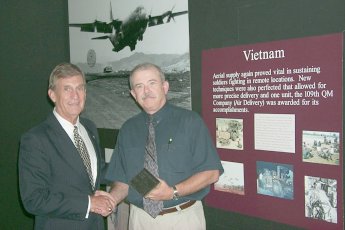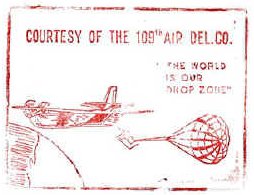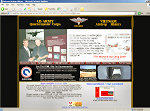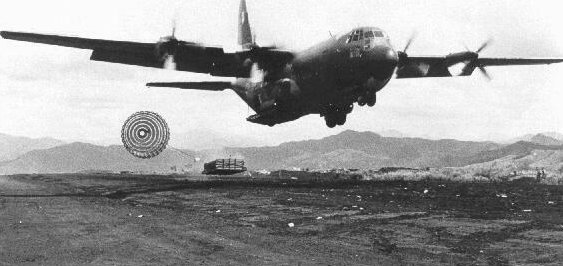|
Update Of This Site: July
4, 2007
|
OFFICE
OF THE QUARTERMASTER GENERAL
US Army 109th
Quartermaster Company (Air Delivery) |
||||||||
 |
 |
|
Left,
COL (R) Albert Lanier, CO 109TH QM CO (AD) 1967-68, Presents the company
Courtesy Stamp to the US Army Quartermaster Museum Curator Mr. Tim O'Gorman
on 16 August, 2002.
Captain Grant, the last commander of the 109th returned the stamp from Vietnam in 1972. Col. Lanier Writes: |
|
The 109th Quartermaster Co. (Air Delivery) was the sole TO&E air delivery company assigned to Vietnam. General Westmoreland requested an air delivery company be included on the troop list and centrally located in country to respond to emergency resupply requests. The 109th arrived in Cam Ranh Bay, RVN in August 1966 under the command of Major Christopher C. Crotty. The unit was assigned to 1st Logistical Command and remained in country until deactivated at Cam Ranh Bay in January 1972. Captain Don I. Grant was the last company commander of the unit in Vietnam. During the 77 day siege of Khe Sanh in 1968, over 8,000 tons of supplies and equipment were dropped in support of the 26th Marines stationed at the outpost. This historical accomplishment was performed by the 109th QM Co. (AD) and the 383d QM Det. (AD) supported by the 623 QM Co. (AER&D) . Operation Junction City and numerous other airdrop missions were accomplished throughout southeast Asia during the 6 year period. Supplies rigged for airdrop were stamped with an oversize stamp so receiving units would know who rigged the supplies for airdrop. In addition to the unit designation, the stamp included the company motto "The World is Our Drop Zone". Stamped supplies promoted feedback from the field and the retrograde of air items. It also helped build customer appreciation and support. Captain Grant retained the stamp upon his return to CONUS in 1972. The stamp with Captain Grant's note "To all those who served, I salute you", found its way to Colonel (R) Al Lanier who commanded the 109th in 1967-68 during the siege of Khe Sanh. The stamp was donated to the Quartermaster Museum on
16 August 2002 by Colonel Lanier. "This stamp is donated on
behalf of Major Crotty, Captain Grant and all those who served in
the 109th Quartermaster Co. (AD) in Vietnam from 1966 TO 1972."
They were all "Supporting Victory" in a manner that
brought great credit to the unit, the Quartermaster Corps and the
US Army. |
|
Vietnam
Airdrop History The following published article includes ALL known US Army Quartermaster Corps Aerial Delivery units that made contributions to air delivery at Khe Sanh from January 21, 1968 to April 1968. Previous articles were written about the 109th Qm Co (AD) role only. This article ties all the QM units together. Research of retired Warrant Officer Lowell Hammel USA (383rd Qm Det., 1st. Sergeant) and retired Lt. Col. Charles Williford USA ( AD Officier, 1st Logistical Command, Captain) allowed all these units to be documented. Also veteran Ray Anderson searching for documents with retired Col. Al Lanier (Company Commander, 109th QM CO (AD), Major) received documentation from the National Archives, 1st Logistical Command collection, to further document this article.
THE
US ARMY QUARTERMASTER AIR DELIVERY UNITS In
1993 a monument was dedicated in Arlington National Cemetery to the
Marines who fought at Khe Sanh, arguably the longest and most bitterly
contested battle of the Vietnam War. This formally acknowledged the
enduring relationship between Khe Sanh and the Marine Corps. However,
it was not only Marines who faced the North Vietnamese Army. The defense
of Khe Sanh was very much both a joint and combined effort by various
American and South Vietnamese forces. In
June 1966 the 109th QM received overseas movement orders.
On July 23, the unit embarked onboard the USNS General John N. Pope
at Tacoma, Washington. The main body arrived at Cam Ranh Bay, South
Vietnam, on August 12 1966. By
November 7 the 383rd moved from Saigon to Cam Ranh Bay and
was attached to the 109th. The 623rd QM Company with resources
to repair air delivery items also shared the 109th QM Company
facilities. The establishment of the 109thís operational area was complete;
General Westmoreland now had the air delivery assets in place
that he requested the previous year. To
meet the threat in the A Shau area an offensive into the valley was
planned for early 1968. The plan called for the 1st Calvary
division to be supplied by airdrops for the first three days of the
offensive. This operation would require seven hundred short tons a day
of air delivered supplies. To accomplish this more riggers were needed.
In December 1967 the 1st Logistical
Command ordered the 383rd QM Detachment to Bien Hoa
to establish another separate Air Delivery Unit . Since
the 383rd was but a single platoon, it was augmented with
a platoon of riggers from the 549th QM Company (Air Supply)
in Japan, a platoon of
riggers from the 173rd Airborne,
and another platoon from the
101st Airborne. An additional platoon of 101st Airborne
riggers joined the 109th to replace the 383rd
platoon of men lost during their move to Bien Hoa. General
Westmoreland estimated the forces size around Khe Sanh at between fifteen
and twenty thousand men. This buildup caused the U.S. command to conclude
that reinforcing Khe Sanh was the only feasible alternative to abandoning
it. Westmoreland ruled out abandonment because a presence at Khe Sanh
blocked the ability of the North Vietnamese to circumvent the DMZ barrier
and bring the war into the populated coastal plain. Before
the offensive into A Shau Valley could be implemented, the siege of
Khe Sanh and the 1968 Tet Offensive began. The large number of riggers
accumulated for the A Shau offensive soon became fully engaged supplying
Khe Sanh and other isolated outposts. Consequently, the offensive into
the A Shau Valley had to be delayed until April of 1968, after the end
of the siege at Khe Sanh. The
109th was rigging supplies at Da Nang and Cam Ranh Bay. The 383rd and its attached platoons were rigging
supplies at Bien Hoa. Cam
Ranh Bay was the safest of these locations, as
Da Nang and Bien Hoa were frequently under rocket or mortar attacks.
Riggers often worked during the night, using flood lights in order to
rig loads for aerial delivery. The
383rd rigged CDS (Container Delivery System) while the 109th
rigged both CDS and extraction systems (LAPES and GPES). The riggers
of the 109th QM geared up to meet the challenge posed by
events at Khe Sanh. Initially, riggers at Cam Ranh Bay worked three
days and two nights continuously without rest. This was followed by
shifts consisting of 24 hours on duty followed by a six hours rest break.
Similar schedules were followed by the 383rd. Army
riggers continued supporting U.S. military operations in Vietnam. The
109th supplied the Cambodia invasion and also rigged the
extraction of captured enemy supplies and weapons. The 109th
QM rigged 350 tons of fuel,
rations, and ammunition for the 1971 invasion of Laos. The 549th
Quartermaster Company, by now in Okinawa, sent 76 men TDY (Temporary
Duty) to Vietnam to aid in dropping 4,853 tons of supplies in 369 sorties
into An Loc during the 1972 Easter Offensive. Like Khe Sanh before it,
the defenders at An Loc held their ground. The US Army riggers pioneered
the use of fuel air explosives by rigging 55 gallons drums of aviation
fuel onto skids of which were then loaded onto C-130ís. Each
of the sixteen skids consisted of 2 barrels of AVGAS and 2 barrels JP4
fuel. The skids would free fall with smoke grenades attached
to assured they would ignite upon ground impacted. In terms of destructive
power, these drops compared to napalm drops but at one-tenth the expense.
The 109th and 383rd both rigged the famous 15,000 pound "Daisy
Cutter" bomb used to clear helicopter landing zones. |





